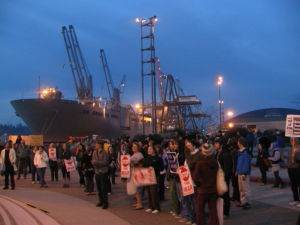
Carly Martin
Fort Lewis has generated dissent from various civilian communities since it began its occupation of Nisqually land in 1917. One of the most significant times of civilian dissent occurred from 2006 to 2009, when a series of protests occurred at the Ports of Tacoma, Olympia, and Grays Harbor. The protests were centered around the shipment of Stryker armored vehicles through the ports, between Fort Lewis and Iraq. The main group of protesters at the Port of Olympia called themselves Port Militarization Resistance, but not all who protested the Port’s compliance with militarism considered themselves to be a part of the group. There were also other groups involved such as Iraq Veterans Against the War, Veterans for Peace, and Olympia Movement for Justice and Peace (Port Militarization Resistance 2019).
Port Militarization Resistance advocated a strategy of ending the Iraq War, through the tactic of making publicly run ports inaccessible to the military (Port Militarization Resistance). After years of trying to persuade elected officials to end the war, the antiwar movement began to use direct action, through tactics such as daily/nightly vigils, picketing, die-ins, banner drops, human blockades, ignoring police-designated “no-backpack zones,” soft-arrest demonstrations, physical road blockades, unpermitted marches, and sometimes property damage. During these protests the Olympia and Tacoma police departments, and other law enforcement, used excessive force through crowd dispersal tactics on the bodies of protesters. Much of this was captured on video by people at the protests; these videos of police violence against protesters were some of the first to be made publicly available through YouTube (Port Militarization Resistance 2019).
Port of Olympia Protests, 2004-06
Beginning of Antiwar Rallies
Significant antiwar protests began in Olympia as early as November 2004, when a group of about 200 people held antiwar signs, and handed out informational leaflets at 15 major intersections around Olympia and the surrounding area. The largest group of protesters was about 70 people gathered on the 4th Ave. bridge, forming a new chapter of the women’s group “Code Pink,” which protested the war all dressed in pink (Bohmer 2004). Beginning November 15th, there were daily vigils at the Port of Olympia for the Iraqi civilians who were killed in the murderous attacks on Fallujah in April 2003 (Bohmer 2004). U.S. soldiers from the 1st Battalion, 325th Infantry Regiment of the 82nd Airborne Division had fired into a crowd of Iraqi civilians who were protesting the military presence at a school in Fallujah (Wikipedia 2019).
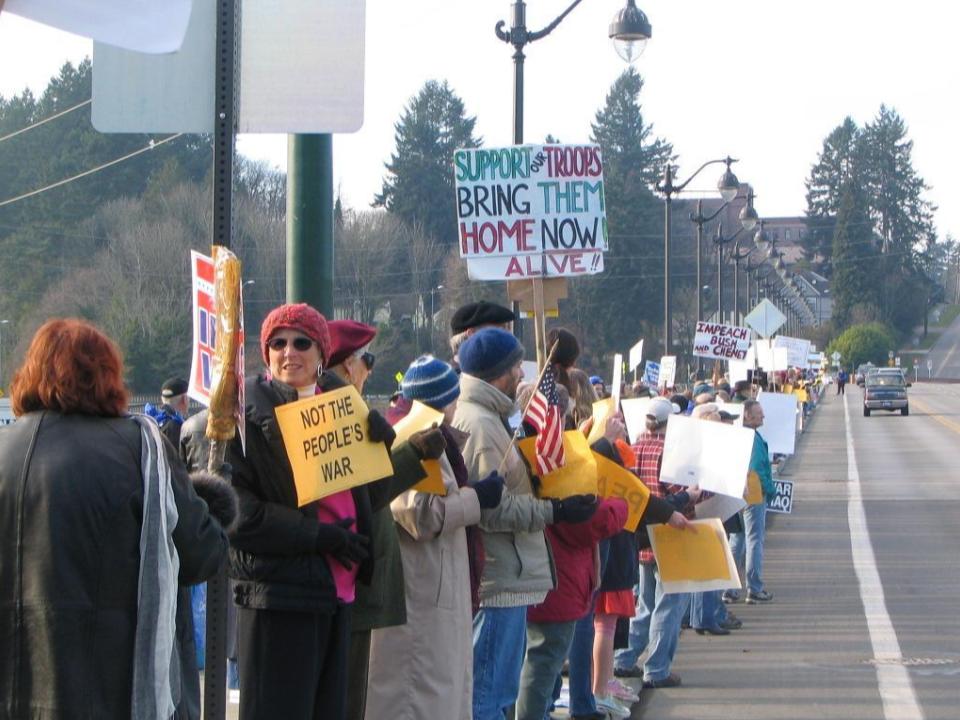
Military Ship Arrives at Port of Olympia
On November 17, 2004 the Navy ship Intrepid landed at the Port of Olympia to be loaded with military supplies from Fort Lewis (including trucks, helicopters, and other various supplies) to be shipped to Iraq the following day. Olympia Movement for Justice and Peace (OMJP) called for a rally the day of the shipment and around 100 people showed up to protest (Bohmer 2004). During this rally, military veterans gave speeches on the best way to support U.S. troops, which they said was to end the war itself. Later that night there was a march to the port, where a few people cut a portion of the port fence down. Two people were arrested that night for trespassing into the port (Bohmer 2004).
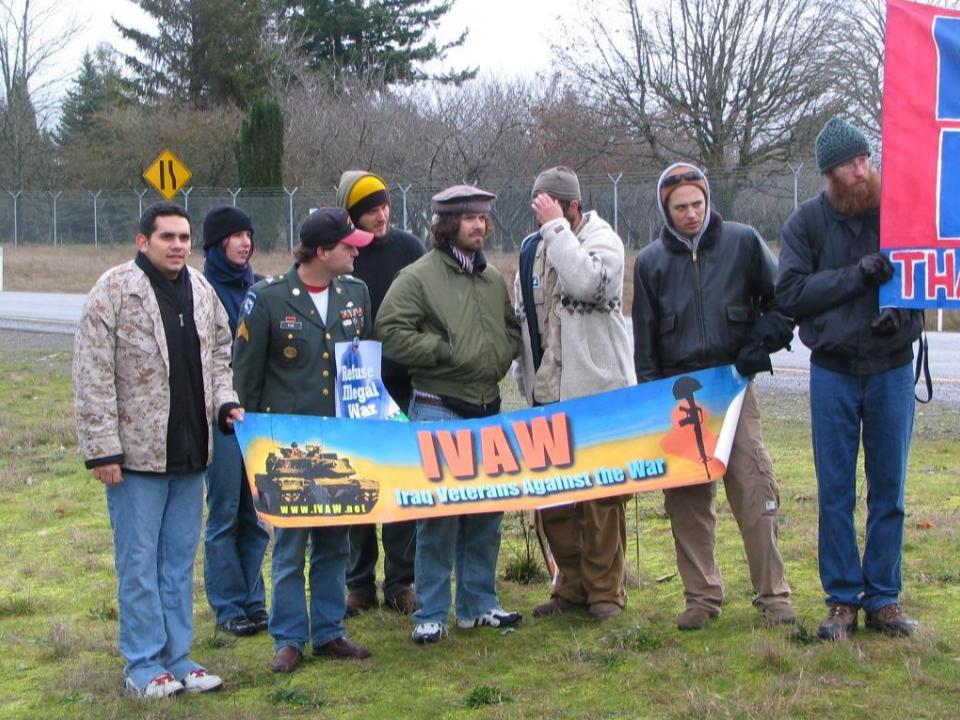
Port of Olympia Commissioner’s Meeting
When the three Port of Olympia commissioners met on November 22, 2004, to discuss the future of the contract between the military and the port, an unexpectedly large crowd of about 150 people turned out. In Washington, ports are owned by the public and run by elected officials, and at the time Port of Olympia was run by three pro-military commissioners. At the meeting, about 40 people spoke out against the port continuing its contract with the military. The Port was losing money (much like today), so some people argued in favor of the military contract because of the money that it could bring to the port. Shipments from the military made the Port a profit of about $600,000 a year and brought more jobs to the Longshore Union (Bohmer 2004). Those who spoke up at the meeting against militarization of the port brought up the fact that the military contract was in fact “a drop-in-the-bucket” in comparison to the $100 billion spent on the war each year. This along with the countless lives lost each year because of the war (both Iraqi and American lives), seemed inconsequential to the money the contract would make (Bohmer 2004). At this meeting the president of the International Longshore and Warehouse Union (ILWU), Keith Bausch, voiced that the ILWU did not support the Iraq War, but did however want to continue the contract with the military to use the port for shipments. The port commissioners however, made it clear that they would continue the contract (Bohmer 2004).
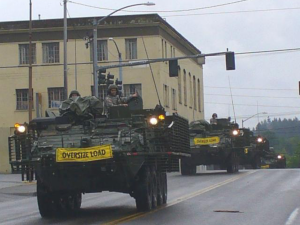
Port Protests begin in Olympia, 2006
On May 22 through May 31, 2006, there were to be around 300 shipments of Stryker vehicles and a total of 20 convoys of trucks coming from Fort Lewis to the Port of Olympia to be loaded onto a ship to be transported to Iraq. This shipment was to be sent to Iraq before the deployment of the 3rd Brigade, 2nd Infantry Division (Szymanski 2006). On May 24, 2006, the first major blockade occurred when Port Militarization Resistance formed a human chain in front of a military truck carrying Stryker vehicles. The activists hoped that if they were able to stop the Stryker vehicles from being sent to Iraq, they could prevent or postpone the deployment of the troops of the 3rd Brigade, 2nd Infantry Division from leaving Fort Lewis (Nguyen 2007). This direct action was ended with brutal force by Olympia police who used pepper-spray as a crowd dispersal tactic and physically pushed, kicked, and dragged protesters off of the street (Olympia Movement for Justice and Peace 2006).
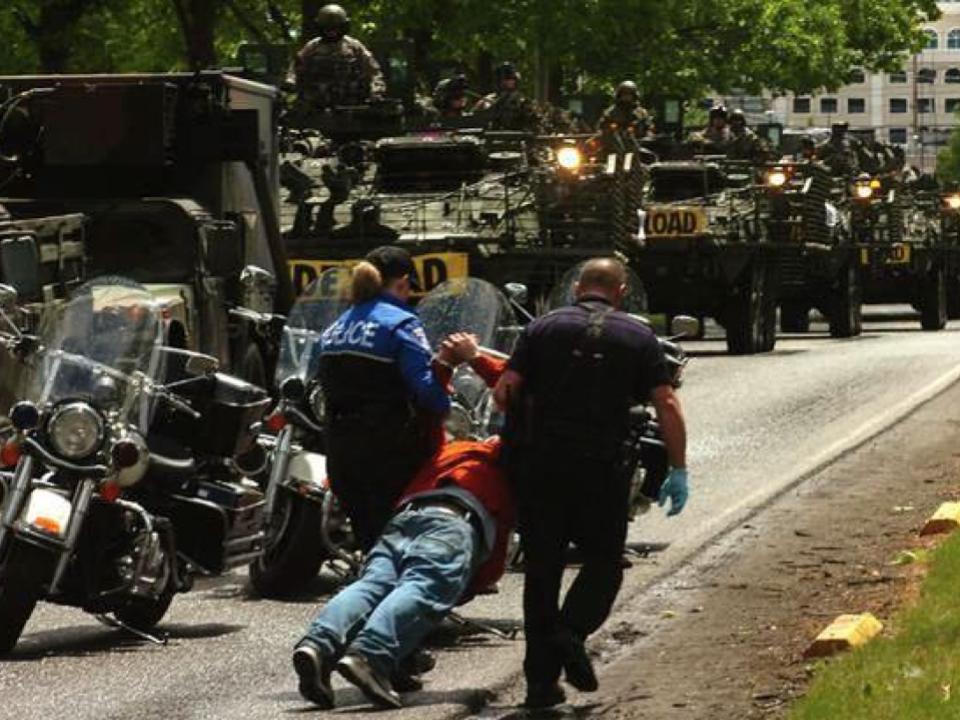
Written Forms of Dissent
Along with all of these larger more visible forms of civilian dissent, there were also countless articles and letters written by civilians either directly involved in some of these movements, or who were in the position of an “observer” of these actions. The written forms of dissent also included people who understood militarization from a more academic point of view and could use this privilege to the movement’s advantage. An example of this was a member of the Olympia Movement for Justice and Peace and Evergreen State College professor Larry Mosqueda, who wrote an article for Counterpunch. Mosqueda described how Bush’s 2003 invasion of Iraq terrorized its people through illegal and immoral actions. Mosqueda pointed out that when soldiers are sworn in to serve for the US military, they swear an oath agreeing to follow only lawful orders under the Uniform Code of Military Justice (UCMJ) 890.ART.90 20. The code states that “military personnel have an obligation and a duty to only obey Lawful orders and indeed have an obligation to disobey Unlawful orders, including orders by the president that do not comply with the UCMJ. The moral and legal obligation is to the U.S. Constitution and not to those who would issue unlawful orders, especially if those orders are in direct violation of the Constitution and the UCMJ” (Mosqueda 2003).
Port of Tacoma Protests, 2007
The Port of Tacoma protests began on the night of March 2 2007 and went on until the afternoon of March 15. The protesters opposed the Stryker vehicles that were coming in through the port to be delivered to the 4th Brigade of the 2nd Infantry Division at Fort Lewis, which was then to be shipped to Iraq on the USNS Soderman (a Large, Medium-Speed Roll On/Roll Off ship). Along with protesting the Stryker vehicles, a few members of the protesting group cut a hole and dug a hole under the fence separating the port from the public. The military chose to convoy at night, most likely to keep the shipments and the militarization of the port seemingly invisible to the public (Abuan 2007).
In an attempt to break up and undermine the nonviolent action of the protesters, the police used violent tactics to attempt to disperse the protesters, by firing pepper spray pellets, bean bags, rubber bullets, and tear gas, as well as using wooden clubs to beat protesters. One protester, a U.S. Navy veteran was tasered three times before being tackled to the ground. At least five people reported being shot with rubber bullets at point-blank range (in the face or chest). On the first night of the protest, three protesters were arrested. A few nights later, more than one hundred people regrouped to protest. Although they did not block the shipment, 23 people were arrested for stepping into the road.
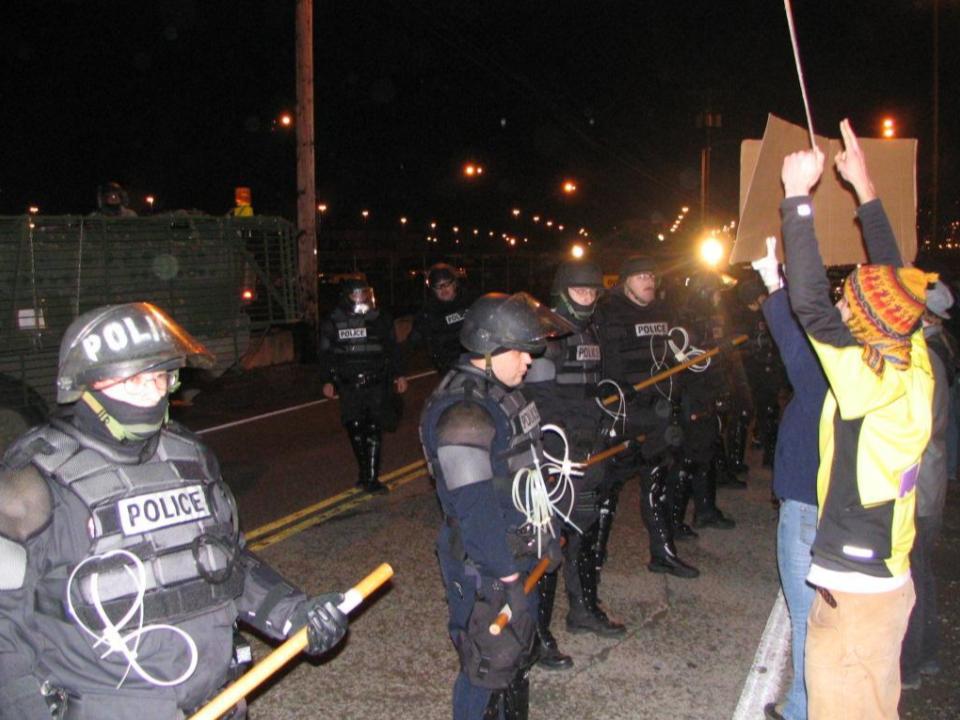
All of these arrests happened due to nonviolent acts of civil-disobedience; some of them facing charges of second-degree trespassing on secured port property after being ordered to disperse. Eight of them were arrested because they were violating a “ban on backpacks” created by the police in the area of protests (one protester had a copy of the Constitution in his backpack). Throughout the week-long period of protests, a total of 37 protesters were arrested in Tacoma (Wikipedia 2019). One person who was arrested had merely spoken at the Tacoma City Council meeting during the time for public comment about the police brutality that the protesters had experienced, and he was arrested for speaking for too long (Wikipedia 2019).
Port of Olympia protests resume, 2007
Protests in Olympia resumed on November 6 2007, when the USNS Brittin returned to the Port of Olympia (the same ship that carried the Strykers to Iraq in 2006). The Strykers returned damaged from raids and were to be convoyed back to Fort Lewis to be repaired and then shipped back to combat in Iraq. When the ship arrived in the Port, people gathered on the 4th Ave. Bridge to protest the incoming shipment. On this same day a group of students in the Port Militarization Resistance group staged a “die-in” at The Evergreen State College on Red Square and in the Computer Lab to bring attention to the 48 soldiers, from Fort Lewis’ 3rd Brigade, 2nd Infantry Division, who had died in combat, and the Iraqi civilians who had been killed in the war. On November 9, 2007, the Port Militarization Resistance formed a blockade with bodies, fences, signs, garbage bins, and cinder blocks and stopped the shipment of armored Stryker vehicles for 17 hours. Police responded the next morning with pepper spray, illegally spraying directly into the eyes of some of the protesters, pushing and beating people with batons, and kicking and pulling people off of the street.
Once this protest was cleared, protesters reconvened at the intersection of 4th Ave. and Plum Street, blocking traffic with dumpsters, cinder blocks, garbage cans, etc. Protesters also blocked the on-ramp to Interstate-5, “locking-down” by linking their arms together through locked PVC-pipes. The police responded by firing pepper-balls and eventually sawed through the PVC pipes, cleared the roadways and the trucks carrying the Strykers eventually got through twelve protesters were arrested during this action (Olympia Movement for Justice and Peace 2007).
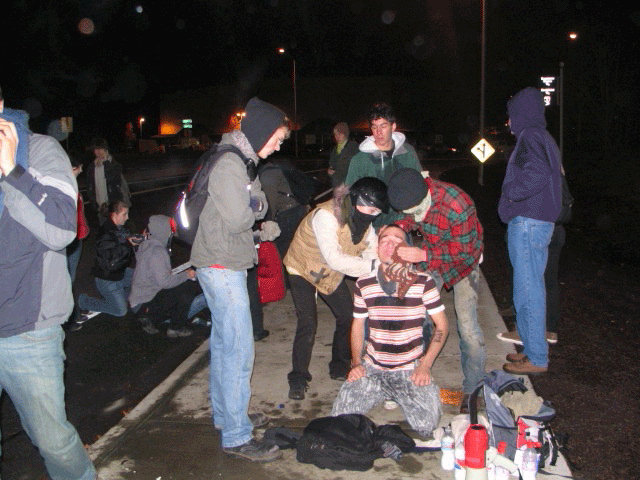
On November 11, Port Militarization Resistance attempted to lay flowers at the gate of Port of Olympia to commemorate the 48 Fort Lewis soldiers who had died in Iraq. The flower bearers were met with pepper spray and three more arrests. On November 12 an unidentified individual poured concrete on the only rail line leading out of the Port. On the morning of November 13, 2007, there was another blockade of the Stryker vehicles, attempting to leave the port by truck. The protesters formed a human chain, quickly blocked the large truck and narrowly avoided being hit.
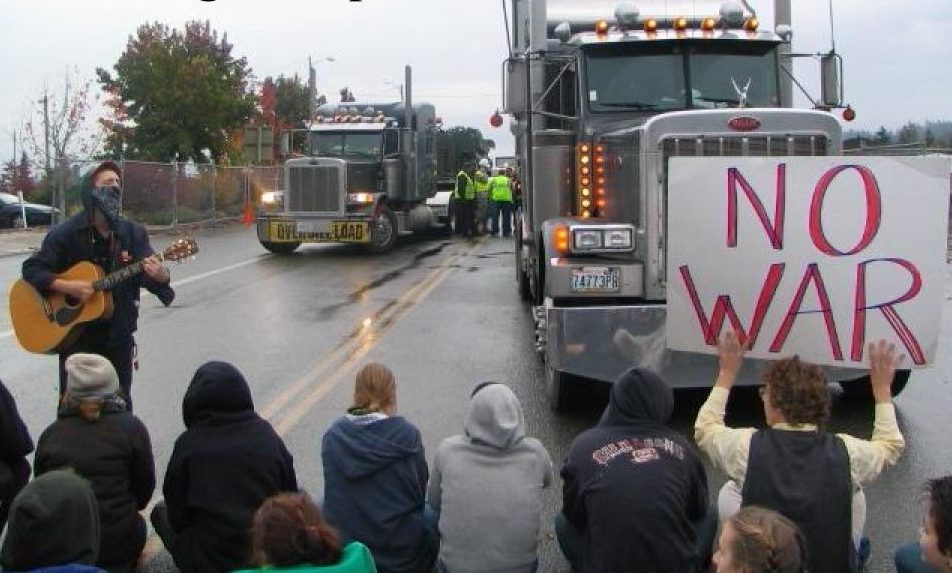
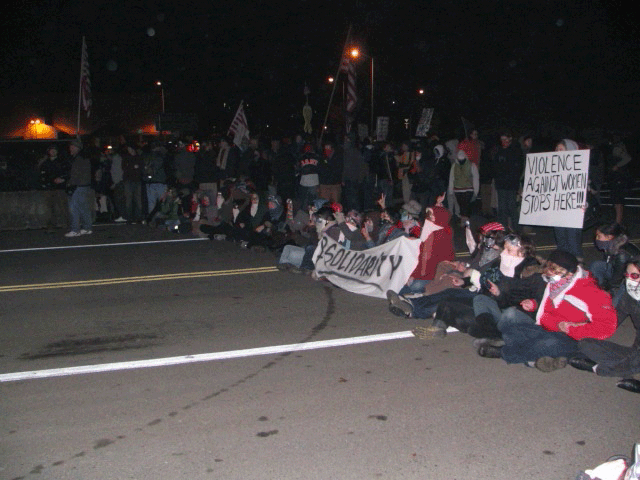
The truck eventually reversed back into the Port, and later that night the blockade continued. This time it was specifically a women’s blockade, organized by women, with men standing in solidarity with them (Nguyen 2007). The police returned once again to arrest the women and then break-up the blockade by force, through pulling protesters off the street and pepper-spraying them (Olympia Movement for Justice and Peace 2007).
On November 15, there was one last blockade to stop the shipments, the protesters were once again pepper-sprayed and five were arrested. That night, there was a candlelight vigil downtown of about 100 people. There was a student walk-out on November 16, where students from The Evergreen State College, South Puget Sound Community College, Capitol High School, Olympia High School, and Lincoln Elementary School walked out of class to protest the Iraq War (Fischel 2007).

Around the same time was another march of about 350 people through downtown Olympia, and the last shipment of Strykers left the Port to Iraq on November 28 with no demonstrations (“Port Militarization Resistance” n.d.). At least 66 people had been arrested in the protests at the Port of Olympia in 2007, and at least 150 people were injured at the hands of the police during the many actions and demonstrations. (Goodman, 2007).
Port of Grays Harbor Protests, 2007
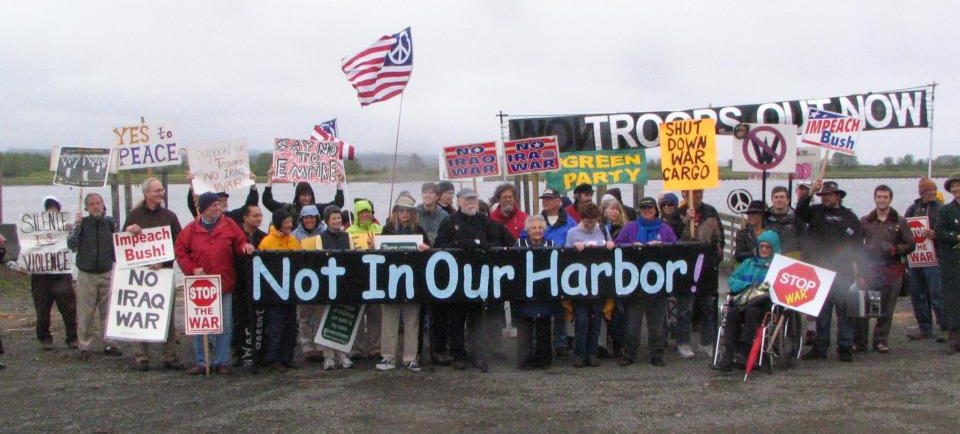
More than 60 protesters marched in Hoquiam around the town and into the Port of Grays Harbor in May 2007 to protest the Iraq War and the use of the Port for military shipping. The protesters did not block traffic, but held up banners and chanted as their form of protest. There were no arrests during this march. Several antiwar protesters believed that Fort Lewis decided to move some of the Stryker shipments to Grays Harbor because the military would not expect there to be as much protest from civilians in Aberdeen and Hoquiam.
Aftermath
At both the Port of Olympia and the Port of Tacoma, following the various port protests, there were debates between the ports, the local governments, and the U.S. Army over who would cover the cost of the police presence to provide security to the port and the many arrests that were made. In Tacoma for example, it cost the city an unbudgeted $500,000 to pay for the police presence, so the city government asked asked the Port of Tacoma to pay for the costs (Associated Press 2007). This “Shell Game” played in favor of the protesters, because of the continuation of protests such as these are seen as a nuisance which makes using the port for military shipments less favorable to both the public and the local government, the ports, and the U.S. Army itself.
Infiltration of Fort Lewis-hired spy
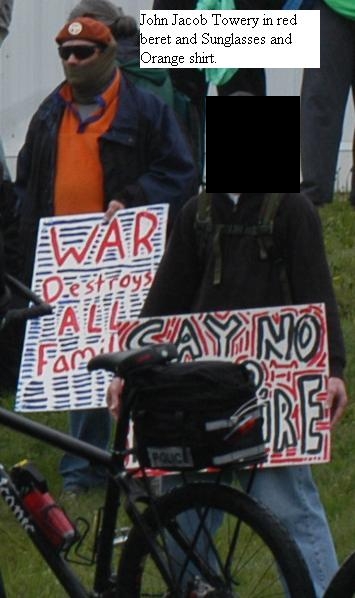
John Jacob Towery, under the alias “John Jacob,” was hired by the U.S. Army Force Protection Division at Fort Lewis, to infiltrate and illegally spy on the Port Militarization Resistance in Olympia and Tacoma, along with other antiwar activist groups such as Iraq Veterans Against the War, Students for a Democratic Society, and the Industrial Workers of the World (Who is John Towery 2009). He had convinced a few leaders of Port Militarization Resistance that he was “an anarchist” and was able to befriend them. Eventually he became the administrator of various email listservs including the Port Militarization Resistance listserv which gave him access to the names, emails, and addresses of local activists. He shared this information (along with other private intel he gained while infiltrating these groups) with the U.S. Army, Air Force, Capitol Police, Coast Guard, Olympia Police Department, Tacoma Police Department, Federal Bureau of Investigation, Washington State Patrol, and Washington Joint Analytical Center (Goodman Moynihan 2012).
John Towery was involved with these groups from September 2007 to July 2009, when he was “outed” as an infiltrator. A Port Militarization Resistance organizer had made a public records request and found countless emails between Towery and the military (Hermes 2017). His actions were in direct violation of the Posse Comitatus Act, which prohibits military involvement in civilian law enforcement. A lawsuit was filed against Towery in the 2010 Panacagos v. Towery case, which went to trial in June 2014 (John Towery: Army Informant 2009). Those who were the victims of the military spying however, did not win the court case against Towery. Larry Hildes, the attorney hired by Olympia Port Militarization Resistance, argued that Towery’s spying “fundamentally compromises the Constitution,” but Judge Leighton ruled in favor of Towery because he was a military employee rather than enlisted personnel. Hildes later stated that he would appeal Leighton’s ruling to the U.S. Court of Appeals for the Ninth Circuit (Pawloski 2014).
Conclusion
The US Army/ Fort Lewis stopped shipping Strykers through the local ports of Olympia, Tacoma, and Grays Harbor in 2008-09. Had the Iraq War continued on longer than it did, it is very possible that the protests at the Ports would have continued as well. The high costs that occurred during these protests because of the police presence, and the conflicts that arose surrounding who would pay for these costs (between the Ports, the local governments, and the Army) would make it difficult and financially irresponsible to continue the military contracts with the Ports of Olympia, Tacoma, and Grays Harbor into the future. Perhaps the protests would have gained more support from a wider group of people if they continued on. The protests that took place at Ports of Olympia, Tacoma, and Grays Harbor showed how dissent against militarization can make it unfavorable public ports to do business with the military, which in turn can help to undermine their war efforts.
Sources
Associated Press. (2007, April 2). Anti-war Protests Cost Tacoma $500,000. Seattle Press-Intelligencer.
Acumensch. (2007, Nov 10). Port Militarization Resistance- Peppersprayed in Olympia. YouTube.
Acumensch. (2007, March 10). Give Peace A Chance— Tacoma Police Riot. YouTube.
Coe, Nathan. (2007). Port Militarization Resistance. Guerrilla News.
Goodman, Amy. & Moynihan, Daniel. (2012). The Silenced Majority: Stories of Uprisings, Occupations, Resistance, and Hope. Chicago: Haymarket Books.
Goodman, Amy & Nguyen, Phan. (200, November 19). 66 Arrested in Washington State Blocking War Shipments at Port of Olympia. Democracy Now.
Gosztola, Kevin. (2015, July 8). Activists Forced to Submit to Secrecy and File Appeal in Lawsuit Alleging Domestic Military Spying. Shadow Proof.
Grossman, Zoltan. (2007, November 14). Olympia Police Attack Protsters. YouTube.
Grossman, Zoltan. (2007, November 13). Olympia Port Protesters Stop Military-Cargo Truck 11/13/07. YouTube.
Hermes, Kris. (2017, April 3). Antiwar Activists Challenge Army’s Domestic Spying Apparatus in Ninth Circuit. Huffington Post.
Hildes, Larry & Dunn, Brandon. (2014, January 13). Press Release. John Towery.
Hill, Christian. (2007, November 6). Protestors of Port Vow to Stop Cargos’ Fort Lewis Return. The Olympian.
Jensen, Mark. (2008, January 31). Jury Convicts Three Defendants in Tacoma PMR Trial. United for Peace of Pierce County.
Mosqueda, Larry. (2003, February 27). A Duty to Disobey All Unlawful Orders. Counterpunch.
The Nation. (2011, June 10). Why Is The Military Infiltrating Peace Activist Groups? YouTube.
Olympia Movement for Peace and Justice. (2005). Port of Olympia.
Olympia Movement for Peace and Justice. (2006). Olympia Resists Militarization of Our Port.
Olympia Movement for Peace and Justice. (2007). Continued Resistance to Port Militarization, Olympia, Tacoma & Beyond.
Port Liberation Front. (2007, Nov. 10). Port Liberation Front Communication (RE: The Last 3 Days). IndyMedia.
Pawloski, Jeremy. (2014, June 19). Federal Judge Dismisses Lawsuit Alleging JBLM “Spy” Violated Olympia Protester’s Civil Rights. The News Tribune.
Richards, Rob. (2007, March 15). Port of Tacoma 3-12-07 #2. YouTube.
Szymanski, Jim. (2006, May 23). Strykers File into Port for Shipment to Iraq. The Olympian.
Wikipedia. (2019a). Fallujah Killings of April 2003. Wikipedia.
Wikipedia. (2019b). Necessity (criminal law). Wikipedia.
Wikipedia. (2019c). Port Militarization Resistance. Wikipedia.
Wikipedia. (2019d). Port of Tacoma Protests. Wikipedia.
Who is John Towery? (2009, November 19). Who is John Towery?. John Towery: Army Informant.
Woodward, Heather. (2007, May 6). Port Protests Shift to Grays Harbor. The Olympian.
